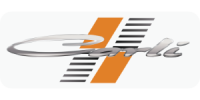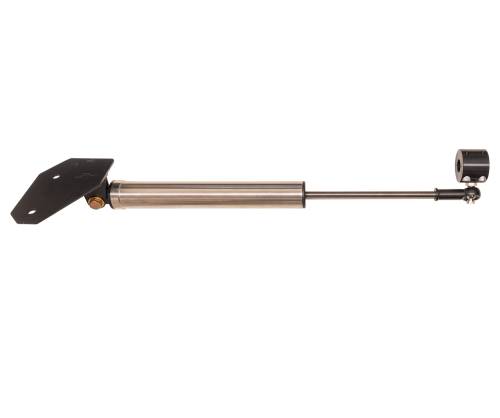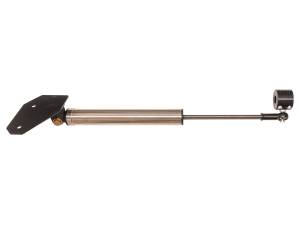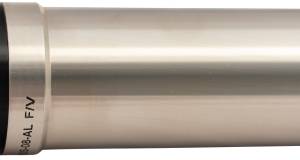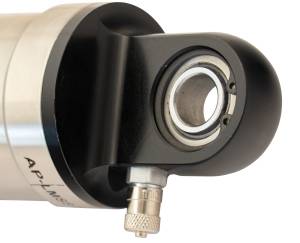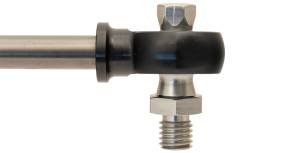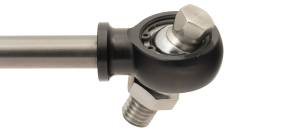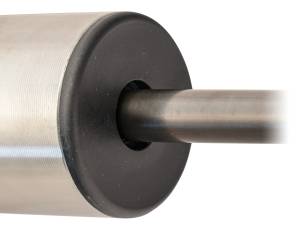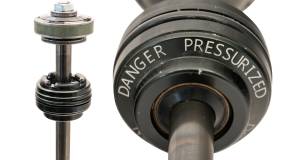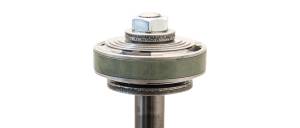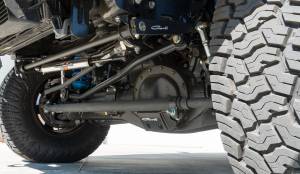CS-DHMSS-14 | Carli Suspension High Mount Steering Stabilizer Kit For Lifted Ram 2500/3500 4WD | 2013-2018
High Mount Steering Stabilizer Kit For Lifted Ram 2500/3500 4WD | 2013-2018
Description
This unique to the industry design eliminates the possibility of destroying your stabilizer on rocks or other obstructions that you may encounter while out on the trails, by adding an auxiliary stabilizer out of harm’s way. Our high-mount Stabilizer consists of a 6061 billet machined clamp with 1/2″ Grade 8 Hardware, a laser cut and powder coated steel bracket, and the elite Carli Suspension Stainless Steel Stabilizer Shock. This steering stabilizer will give you the positive feel through the steering wheel that you are looking for while reducing tie rod slop. It will also help to correct any right pull from the larger more aggressive tires.
The stainless steel schrader valve shock we use is an Internal Floating Piston shock. This means there is an internal dividing piston which keeps the oil and nitrogen separated. The nitrogen gas maintains constant pressure against the low mass “floating” dividing piston and the column of hydraulic oil, virtually eliminating the possibility of oil foaming or performance loss commonly seen in emulsion style stabilizers sold by competitors.
What is a Steering Stabilizer?
Contrary to popular belief, It’s not a magic cure for a wandering truck and it won’t fix your death-wobble. Well, it may mask Death Wobble and certainly helps ward it off by damping front-end forces leading to it but, I digress – read our other blog article if you’re after a fix for death wobble… A steering Stabilizer is simply a damper designed for your steering. A Steering Damper’s purpose is to increase steering predictability while minimizing volatility, road noise and driver fatigue. Simply put, a good steering stabilizer will stabilize the steering; shocker, right?
Stock Steering Stabilizers are designed for stock steering and stock tires. They work well in this application (for about 50,000 miles) and ONLY this application. Throw on a Carli kit and some 35” or 37” tires and you’ll be left wanting. When the tire size increases, the stabilizer should be upgraded as well. Larger, aftermarket tires are significantly heavier and harder to control than factory tires, even in on-road applications.
Types of Stabilizers:
There are two main types of aftermarket stabilizers, Emulsion and IFP (Internal Floating Piston). Both are “gas” charged and contain oil. Emulsion shocks are significantly cheaper than their IFP counterpart. These dampers mix the oil with the gas charge. Although the oil is pressurized by the gas, emulsion shocks do not function well in horizontally mounted applications; i.e. steering stabilizers. When mounted on its side, the oil rests on the bottom as it’s heavier than the gas which rises to the top. The result, a piston that’s only half-submerged in oil. When the piston starts working back and forth, it’s sloshing and foaming the oil offering almost no damping. These are the stabilizers you’ll normally find in cheaper, dual steering stabilizer kits that are more for aesthetics than performance.
These are abundant. A quick google search for “Emulsion Shock” or “Twin Tube Shock” will reveal their short life, tiny pistons and piss-poor ability to control suspension or steering. The only box they check… CHEAP.
Ensuring maximum utilization of the proprietary valving, ALL Carli Stabilizers are IFP Shocks. In short, the IFP shock boasts a second piston internal to the shock body know as the Dividing piston (noted by the Green O-Ring in the below picture). This secondary piston separates the nitrogen cavity (RED) from the oil (Blue). This allows the shock to be run in any orientation – i.e. on it’s side (stabilizer) – as the adjustable nitrogen charge pressurizes the oil cavity ensuring the piston is always submerged thus engaging the proprietary valving on the piston as efficiently as possible.
The nitrogen charge pressurizing the oil cavity also increased the heat-tolerance of the oil while eliminating cavitation (foaming).
Construction:
The main talking point is what stands this stabilizer head and shoulders above all other stabilizers – the body is made of solid 304 Stainless Steel. The raw-machined finish of this stabilizer attracts machinists and laymen alike; it’s truly a thing of beauty.
At the and of the stainless body you’ll find the aluminum Top-Cap. This cap, machined from a solid piece of billet then anodized black, houses a teflon-lined 1/2″ bearing and o-ring style schrader valve.
The Schrader valve allows the customer to bleed the pre-charged stabilizer. It comes pressurized to 200psi when shipped from our warehouse. Many who add this stabilizer are combating a radial tire pull to the right or left (which direction these stabilizers “push” depend on mounting points/hardware – more on this in “Applications” below). Customers desiring a high-end stabilizer that damps their steering without “pushing” can use the provided cap to lower the pressure of the stabilizer (to a neutral pressure spec: 40-70psi) so the nitrogen charge provides all the IFP functionality without directional compensation.
On the other end of the stabilizer, another billet rod-end houses another 1/2″ bearing. We offer a short and long version of this rod-end depending on application. Mounting provisions often require every-bit of the bearing misalignment of which these stabilizers are capable. To ensure bind-free performance, we machine and pre-install our 17-4 Stainless high-misalignment pins to the rod end, where necessary, to allow even more range of motion for the rod-end bearing.
You’ll likely notice the shaft is darker than our Fox or King offerings – this is due to the nitriding (heat-treat) process. Nitriding the shaft case-hardens (hardens the wear surface) to ensure unapparelled corrosion resistance while increasing the material’s fatigue life. What this means to the laymen, we’ve not seen a single pitted/rusted shaft since the release of our Stainless Stabilizers.
Internals:
Wiping contaminants from the shaft is a plastic gunk-guard. This is the first line of protection keeping road grime from entering the oil.
Pop off the dust cap and remove the snap ring and you’ll find what’s being protected – the main seal housing. There’s shaft-guide and seal within this seal housing secondary to the dust’s caps seal to further prevent debris incursion. The main seal housing functions exactly as its name implies. Secured in place by a snap-ring, this is the main guard against contaminants to the shock internals.
Above the main seal housing is the piston we’ve custom valved for larger, aftermarket tires. This robust valve-stack makes short work of damping road force from transmitting to the steering wheel even with 37″ tires increasing rotating mass by 50% over a stock tire. Abundant are complaints that aftermarket stabilizers will stiffen the steering wheel and prevent the truck from returning to center after a turn requiring manual correction. This is NOT the case with the Carli stabilizers; one could run high and low mount stabilizers with stock tires without experiencing any wheel stiffness. We worked to ensure our stabilizers provide a damped, yet active feel to avoid the numb, stiff feeling found in most aftermarket stabilizer kits.
– Direct bolt-in
– Corrects right tire pull, adjustable
– Fits Leveled & Lifted trucks, ONLY.
– Does NOT Fit with Factory Power Wagon Sway Bar.
– Fitment: 2014-18 Ram 2500, 4×4
– Fitment: 2013-18 Ram 3500, 4×4
Application List
2013-18 Ram 3500, 4×4
Details
- CS-DHMSS-14
- CS-DHMSS-14
- 883584147725
- Carli Suspension
- New
Categories
Shipping Information
- Item Requires Shipping
- 11.0 lbs.
- W7.0000” x H3.0000” x L30.0000”
- Free Ground Shipping | Exclusions Apply*

